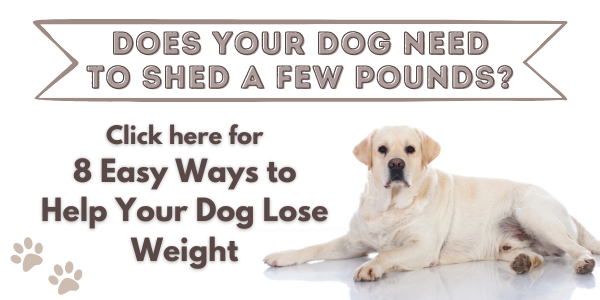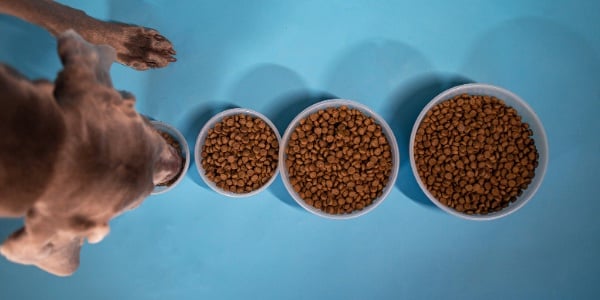 A cup is a cup, oh yup, oh yup, unless that cup is the cup my vet talks up! What in the world can this mean?
A cup is a cup, oh yup, oh yup, unless that cup is the cup my vet talks up! What in the world can this mean?
Depending on the situation, when we are asked or think about a cup, our answers will be very different.
When we think of a cup of coffee, especially if the morning is a bit rough, a cup better be the size of a soda bottle.
But if we think of a cup of espresso, we think of a tiny cup. Either way, we just think of a cup.
How Much Should You Feed Your Dog?
Dog Calorie Intake Calculator
Counting Your Dog's Calories Matter
How Often Should You Feed Your Dog?
Why should this matter to you? It matters because when it comes to your dog’s weight and their overall health, the myriad of empty containers people frequently use to scoop their pet's kibble aren't the “cups” we veterinarians (and the back of the pet food bags) are talking about.
This especially becomes a problem when a pet owner feeds the number of cups the pet food bag suggests — something we will discuss later — AND they are using the extra-large coffee cup variety.
Let's look at how much food you should actually be feeding your dog, how often you should feed them, and ways to help cut the calories if your pet is overweight.
How Much Food Should You Feed Your Dog?
I feel I must get on my soapbox. We all look at the back of the food bag for the recommended feeding amounts. While this is a good start perhaps, we must keep a few things in mind.
First, the guidelines for feeding amounts are typically based on mature intact (not neutered) male dogs. Intact male dogs typically have a higher metabolism and can consume more calories than the average canine, especially a spayed or neutered one.
Second, the range for the weights for feeding is relatively wide on many food bag recommendations. For example, on my dog’s food bag the first range is 3–12 lbs.
One should never feed a 3-pound dog anything close to the amount a 12-pound dog would eat. Here's a photo example showing a range of guidelines from another Preventive Vet team member's dog's food — notice how the range gets wider for larger dogs:
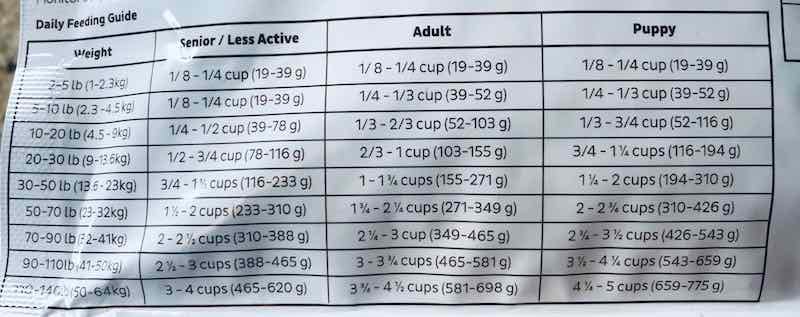
You should feed based on what the ideal body weight is for your pet. For example, if your dog’s ideal weight is three pounds, start off feeding at the bottom of the range. Do not feed based on actual weight if your pet is overweight.
If you find your pet is gaining weight at that amount, you may need to cut back on the amount of food (also be sure you aren’t giving too many treats – better to cut those back than your pet’s main diet!)
Third, you must remember that each dog is an individual and their body structure and metabolism is unique to them. For example, dogs that are working dogs have a higher metabolism (more muscling and activity) and are burning more calories than a dog sleeping on the sofa. They need more calories to maintain weight.
This is why there are performance diets designed to meet their needs, and as an owner of an athlete you will need to provide the needed calories for that lifestyle. Therefore, you must feed your dog based on your dog’s uniqueness!
Wondering how many calories your dog needs? We've created a calorie intake calculator for dogs that will give you an estimate on their needed daily calories to give you a starting point. Click here to jump to the calculator below.
Another example is my small dog’s bag of food suggests he should get ½–1 cup a day. My little porker is very lazy, hates walks, and loves food. Now granted, he gets plenty of treats for being a good boy, but I only feed him about ¼ cup of food per day.
If he gets more, he gains a lot of weight. Excess weight on him could cause back and joint issues. By measuring his food or any other dog’s food, I know what amount is enough for them to maintain weight.
The best thing to do is consult with your veterinarian as to the proper amount of calories to feed your pet.
Using a Digital Scale to Measure Dog Food
As doctors always say, “The scale don’t lie!” That is why measuring your dog’s food by weight rather than volume is more accurate. While a measuring cup is great, we can always be off a little when we eyeball how much is in the measuring cup.
But when you know the weight of what you should feed your dog, you can be exact every time you feed with a digital scale. A kitchen scale can work, or consider using a handheld digital pet food scale like this portable and handheld one from Petfusion, which makes it easier to measure weight quickly or while on the go.
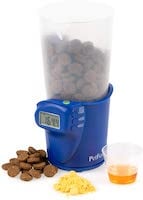 PetFusion Digital Pet Food Scale and Scoop
PetFusion Digital Pet Food Scale and Scoop
Buy on Chewy | Buy on Amazon
How Many Calories Does Your Dog Need?
Every dog is different in the number of calories they need every day to stay at a healthy weight. We've created a calorie intake estimate calculator below to help you determine a starting point (or "ballpark" estimate) for your dog's daily calories.
The result is based on your dog's activity level and current weight — so it's important to think of this as just a starting point for your dog's daily caloric intake! Every dog's metabolism is different and influenced by a variety of factors that are near impossible to work into an exact calculation. Your dog may need more calories than the calculated estimate or they might need fewer calories.
Pay attention to your dog's body condition and discuss their ideal weight with your veterinarian to ensure they are maintaining a healthy weight.
This calorie counter applies to dogs that DON'T have special nutrient needs, such as growing puppies, pregnant or lactating females. Growing puppies and dogs who are pregnant or lactating need to have their weight monitored by their veterinarian.
Enter your dog's current weight and activity level in the calculator below
- Average Activity Level: 30–60 minutes of exercise each day
- Inactive/Senior Activity Level: 15–30 minutes of exercise each day; or over 7 years old
- Active Activity Level: 60–120 minutes of exercise each day
You can also check out this calorie calculator from Vetcalculators with more data points.
Why Tracking Your Dog's Calories Matters
Why is measuring your pet’s food and knowing how many calories they're eating every day so important? Because the pet obesity rate in the U.S. (and in many other countries, too) has truly ballooned to epidemic proportions.
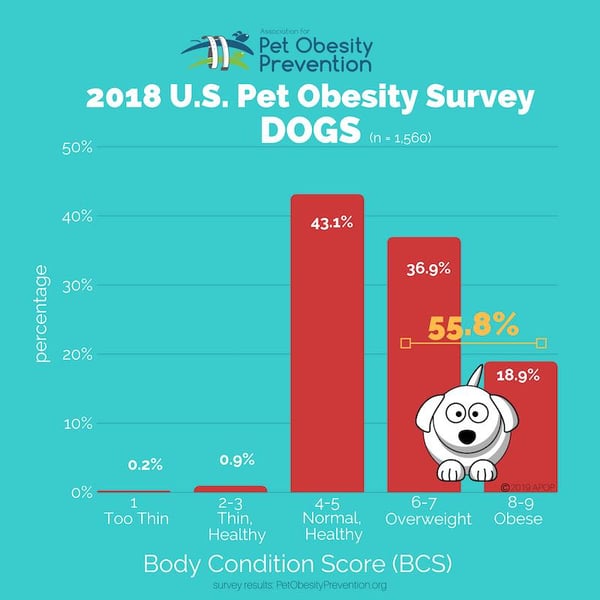 Obesity in pets contributes to other health issues such as osteoarthritis in dogs or potentially diabetes in cats. And while overfeeding a pet their regular food isn’t the only contributing factor, it certainly is a big one — and it’s typically easy to change.
Obesity in pets contributes to other health issues such as osteoarthritis in dogs or potentially diabetes in cats. And while overfeeding a pet their regular food isn’t the only contributing factor, it certainly is a big one — and it’s typically easy to change.
There are HUGE advantages to measuring your pet’s food. For one thing, your pet will be much healthier. Animals at ideal body weight are easier for your veterinarian to examine, and it also allows for more accurate bloodwork results.
Additionally, since medications are based on weight, you not only have to administer less medication (that is especially nice with cats!), but you also save money.
While some medications are based on your pet’s exact weight because of how they are distributed throughout the body, others are based on your pet’s ideal body weight. If your pet is overweight or obese, your pet’s veterinarian has to make assumptions as to what their ideal weight is.
Therefore they may be safe, by using a slightly higher weight than the true ideal of your pet. This can make a big difference in the cost of medications.
Typically, heartworm prevention and flea/tick prevention are more affordable for lower weights. Just a couple of pounds can be the difference between what dose your dog gets if they are on the borderline of two different sizes.
Lastly, you will save a bunch of money on pet food because you are not overfeeding your pet and therefore not going through a bag or can of food as fast.
How Often Should You Feed Your Dog?
The answer to this question is dependent on your dog’s age, size/ breed, activity level, and health issues. Below are general guidelines for how often to feed your dog, based on their age, size, or activity level.
Note that there are some health issues that require more frequent feeding. Your veterinarian can advise you in these cases.
Remember — the recommended feeding amounts on the back of your dog's food bag are for the total amount of food each day, not for each meal. Make sure to portion out this amount across your dog's regular meals.
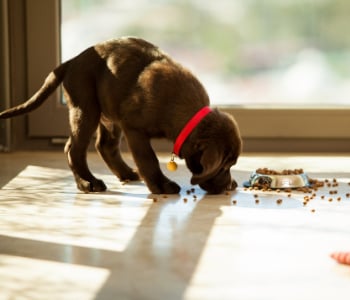 How Often Should You Feed Your Puppy?
How Often Should You Feed Your Puppy?
Generally, it is recommended to feed puppies every 6–8 hours (three to four meals a day). Puppies are more active and therefore need more calories.
In addition, puppies usually need to use the potty about 10–15 minutes after eating.
By sticking to a regular feeding schedule, it can help make potty training your puppy go faster and easier. Need an easy way to track your puppy's mealtimes and potty training schedule? Download this free Puppy Potty Log.
How Often Should You Feed Your Adult Dog?
Dogs over 5 months old should be fed every 8–12 hours. One main reason for this twice-a-day schedule instead of once-a-day meals is that stomach acid and bile can build up in your pet’s stomach. If your dog does not eat, they will become nauseated and vomit.
How Often Should You Feed Your Senior Dog?
Senior dogs need to be fed as often as adult dogs, so at least twice a day. However, senior dogs are fed a smaller amount because they are less active and do not burn as many calories. A senior-specific food formula is best, and it's always a good idea to consult with your veterinarian about what food and how much your senior pet should be eating to maintain a healthy weight. Speaking with your veterinarian is also important if your senior dog has any health issues.
How Often Should You Feed a Toy/Small-Breed Dog?
Certain breeds, such as Chihuahuas, or very tiny dogs, are often fed more frequently in a day. This is because they can become hypoglycemic (low blood sugar) and need food to keep their blood sugar up.
How Often Should You Feed a Large-Breed Dog?
Giant breed dogs usually need to consume more calories to maintain weight. But you don’t want to overfeed at a single meal because this can increase the risk of GDV/bloat. For this reason, meals are spread out to two or three per day. Typically I do not recommend feeding more than 2.5–3 cups per feeding.
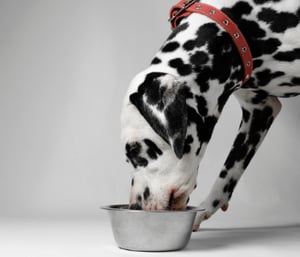 How Often Should You Feed an Active Dog?
How Often Should You Feed an Active Dog?
Dogs that are athletes or highly active typically need a lot of calories. As with giant breeds, you don’t want to risk overfeeding at one single meal.
Athletic dogs sometimes need to be fed up to four times a day. In order to prevent the chance of bloat or other gastrointestinal issues, do not feed your athlete dog within two to three hours of activity.
Remember how important it is to measure your dog’s food and feed them based on their best weight and body condition so that they have a long and healthy life.
If your dog needs to lose some weight, check out "8 Easy Ways to Help Your Dog Lose Weight" for tips on canine weight loss — plus ways to avoid a "hangry" pup as you cut back calories!



